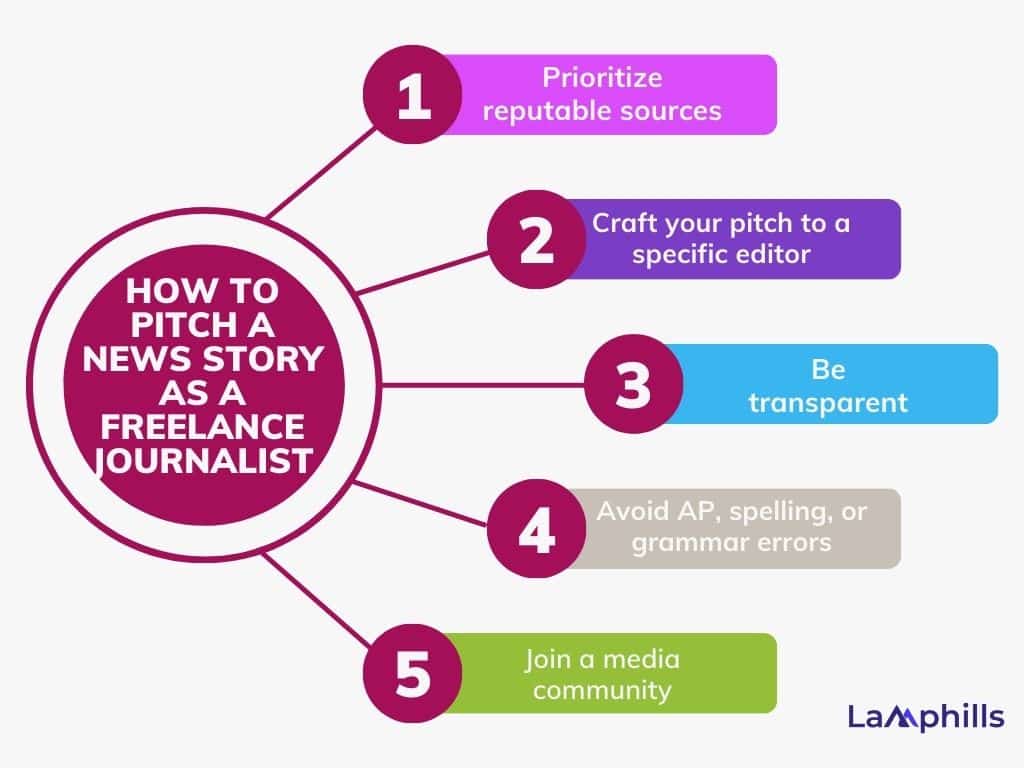If you want to win press coverage, then you need to master two things. First, you must know how to write an effective pitch to journalists. Secondly, you must know how to properly contact the media about your story.
A media pitch is how you attempt to get a journalist or editor interested in your news so that they decide to cover it, resulting in media coverage. While it is mostly done by mail, you can also pitch to journalists via social media platforms, telephone or even traditional mail, for the old-fashioned ones.
Although pitching journalists is similar to sending a press release, the key difference is that a media pitch does not have to include one.
Key Takeaways
- If you want to pitch to journalists, you need to know how to write an effective pitch and how to properly contact the media.
- A media pitch is a brief description, usually no longer than 500 words or two paragraphs, intended to convince an editor to commission your piece.
- An effective pitch should be concise yet compelling, typically ranging from a few sentences to a short paragraph.
- The goal is to capture the essence of your idea while piquing the journalist’s interest.
- Before writing your media pitch, you should first find relevant media contacts to prepare a media list.
- Knowing what to include in your media pitch—and what to leave out—will greatly improve your chances of getting a reply.
What Is A Media Pitch?
A media pitch is a brief description, usually no longer than 500 words or two paragraphs, intended to convince an editor, agent or publisher to commission the piece. Writers in various industries use pitches to encourage an organization to publish their work.
Though the exact content included in a pitch depends on what kind of industry you work in, most pitches include:
- An introduction that describes your story, conflict and point of view
- An explanation of what differentiates your story from others and makes it important or interesting
- An expected deadline for the piece
- Your contact information
- A sample of your work
For example, a journalist may email the editor of a newspaper or magazine to explain an idea for an article. The editor decides if the article idea fits their publication and if the journalist has the right qualifications to produce the piece. Similarly, a scriptwriter may pitch a screenplay to a movie producer by describing the plot and characters.
How Long Should A Pitch Be?
An effective pitch should be concise yet compelling, typically ranging from a few sentences to a short paragraph. The goal is to capture the essence of your idea while piquing the journalist’s interest: “Pitches with body lengths between 50 to 150 words had nearly double the average overall response rate at 5.06%.”
Think of it as an elevator ride: you have limited time to make an impression, so every word should count. Ideally, your pitch should quickly convey the core of your story, its unique angle, and why it’s relevant to the publication or audience, all without overwhelming the recipient with excessive detail. If they’re intrigued, they’ll ask for more.
What’s the best way to order the information in your pitch? Consider a structure that most journalists use when reporting “hard news” stories, short, punchy pieces that are straight information—The Inverted Pyramid.

The Inverted Pyramid is a way of organizing information for the news that starts with the biggest and most newsy, bold-faced information up top. As the piece (or pitch) continues, the information becomes more granular, with extra color and details that are part of the story or pitch but not necessarily essential.
How To Write A Media Pitch To Journalists
If you’ve written any type of email pitch before, you’ll quickly realize that writing a media pitch is similar. There are, however, a few key differences that you have to keep in mind.
We’ve broken down writing a PR pitch into 7, easy-to-follow steps:
#1. Make sure your story is newsworthy
It’s all in the subject line. If you want to get someone to cover your story, it’s worth asking yourself these two questions before you even think about pitching the media outlet:
- Is my news actually newsworthy?
- Is my news presented in an exciting way that will get people interested?
The best pitch emails answer these questions with a resounding, “yes!” If not, it might be worth waiting until you have something that is actually newsworthy.
Also, when crafting a press release that you might send in a pitch, it is vital to take into account your target audience and the preferences of journalists from the outset.
For example, outstanding book press releases give readers an enticing glimpse of what lies ahead, avoiding spoilers, while sports journalists need short, “twittable” quotes and a set of statements from athletes.
Otherwise, you could make a bad first impression with the media contacts you send your press release to.
What makes a newsworthy story? According to socialmediasydney.net.au, you should consider the following:
- Is the story new and current?
- Does it feature an element of prominence?
- Does it evoke an emotional response?
- Will your story affect or have an impact on certain people?
- Is your story relevant to the area/publication you are pitching it to?
#2. Make sure you’re pitching relevant media contacts
Before writing your media pitch, you should first find relevant media contacts to prepare a media list, which is a list of people who could be interested in covering your story. In addition to journalists, this could include social media personalities on Linkedin, influencers, bloggers, podcast hosts, and even other PR Professionals.
In the media, individual journalists have their own specializations (referred to as a “beat”). Instead of sending your pitch to the general email address of a news outlet, it is best to address it to the person most relevant to the subject you’re writing about. In other words: make sure you’re knocking on the right doors before you start knocking.
Example: If you’re a small business or startup that’s launching a new product and you’re reaching out to a magazine like WIRED, Forbes, or the New York Times, you’ll find out that every reporter there has their own specialization, such as drones, cell phones, or cloud computing. In this case, the right thing to do would be to reach out to the person that writes about products like yours, instead of pitching to someone that generally covers technology.
#3. Write your subject line
When writing a media pitch subject line you want to keep in mind that this is your big first impression, this is the first thing your selected journalists will see and you want it to make a mark and get your email opened.
So remember these simple rules:
Keep things clear
Simply put, be sure to say it is a pitch. You don’t want to hide your email behind flowery language and get your pitch lost in a journalist’s already overflowing inbox. So put the name right on the label to keep your intent clear and your pitch easy to find.
Keep things short
You might be tempted to dress up the subject line with extra buzzwords and enhancing language. I mean what’s even better than a new product? An exciting new product, of course! But the subject line is simply not the place for it. A good guideline to keep in mind is you want to keep your subject line under 49 characters, total. Doing so is proven to boost your open rates and more.
Here are a few quick media pitch subject line examples:
- Pitch: Interview: Therapist and Entrepreneur on How to Manage Everyday Stress
- Pitch: 83% of cold pitches are irrelevant and ignored, journalists say
- Pitch: Why You Need To Stop Wearing Your Cell Phone In Your Pocket
#4. Grab their attention early on
Let’s start at the very beginning, the address line.
You want to address your pitch as precisely as you can, ideally with your journalist’s name and professional titles. If you’re using a media contact database this information should be in easy reach. “To whom it may concern,” may have floated you once or twice, but it’s a poor beginning to establishing meaningful relationships with your chosen journalists. That personal touch can work wonders.
This is also a good moment to double-check your chosen journalist’s beat, or their field of expertise, to be absolutely sure you’re pitching to the right person. Once you have that checked off the list, what next?
Get straight to the point
Your journalist is going to want to know the big W’s: Who, What, When, Where, and Why?
So it’s best to put these right up front. These should make up the content of your opening paragraph so the journalist can be sure that your news covers their and your audiences’ interests. This is best encapsulated in a compelling lead that includes your trending topic and your timeframe. Remember, there’s no news like fresh news.
Offer an appealing angle
By providing journalists with different options for how to cover a story, you increase the chances that they will find an angle that fits their publication’s style and target audience, and thus you’ll be more likely to gain press coverage.
#5. Write an email that connects
You want to write content that the journalist can see will resonate with their readers. You want to make sure that you and the journalist are on the same page, and that the journalist has ready angles that they can use to frame your story to their readers.
Trust us when we say that journalists love it when PRs do some of their work for them.
But there are a few things that you can do to make sure your news really stands out amongst media pitches:
Give them expert sources
What did we say about doing the journalist’s work for them? Your chosen journalist may well have their own expert sources in mind, but the more the merrier! You may even find a few that are truly unique to your article, such as academic experts or a CEO, that can grant your story extra strength.
Send them relevant links
Generally speaking, you don’t want to bog down your pitch with excessive graphs and data, but you can still include these with carefully chosen external links related to your news. This can increase reader engagement and enhance your credibility, both with your journalist and their audience.
Tell them what you’re offering
You’ve already gone through the trouble of hand-picking what journalist and news outlet to pitch, so why not share why you chose them? Mentioning your criteria and why you chose to pitch them exclusively can help personalize your pitch and reinforce your relationship.
Story pitch email template
#6. Make your call to action
A carefully crafted call to action is an absolute must. Ideally, you want to express why this story matters, how it is relevant to your journalist’s readers, and reinforce your timing. This is your moment to keep things focused on your audience, your journalist, and their readers.
7. Conclude your media pitch
Your conclusion should be a boiled-down summary of your pitch but presented in reverse. You can begin by restating your call to action in a fresh and unique way, adding any last relevant data or links that the journalist might find useful, and finally thanking your media contact for their valuable time. Remember to use a unique and polite sign-off and, finally…
End on your boilerplate
You know what this is. In the end, you want an easy and accessible summary of all your essentials. Your contact details, your background, why you’re the perfect person to pitch this news, and any professional achievements relevant to your pitch and your news.
How to Pitch A News Story to a Journalist
Before you begin, keep these in mind: journalists and editors are flooded with press releases, media pitches, and various other demands on their time and attention. Based on research from Fractl, 46.5% of journalists receive at least 11 media pitches per day, while 28.64% receive over 26 pitches daily.
Hence, knowing what to include in your media pitch—and what to leave out—will greatly improve your chances of getting a reply. Also remember that even a single typo in a cold pitch is enough to turn possibility into disaster.
Start with an engaging hook or statistic to grab their attention. Clearly articulate your proposed piece’s main angle or unique perspective, demonstrating its relevance to the media outlet’s audience. Highlight potential sources or unique insights you’ll bring, and conclude by briefly establishing your credentials or experience related to the topic.
Tailoring the pitch to align with the publication’s style and content demonstrates your familiarity with the outlet, enhancing the likelihood of acceptance.
How To Pitch To A Journalist
How To Pitch To Journalists: Customizing Your Pitch For Various Mediums
Your pitch will be different depending on the medium you’re pitching. A broadcast journalist is looking for a very different story than a print journalist or a podcaster.
Podcasts
One of the most fundamental differences between your strategy for pitching traditional journalists versus podcasts comes very early on in the process: in the research phase. Unlike a traditional media outlet which will generally accept pitches and hold interviews with key stakeholders in stories they are crafting, some podcasts do not invite guest speakers to be on the show.
There are many different podcast formats, and if the podcast you’re pitching doesn’t take guests, you’re wasting your time, so it’s important to find that information upfront.
TV
The most important difference may seem obvious, but it’s worth a deeper dive. When pitching TV, your story must be visual.
Plus, you should be familiar with the show you’re pitching. Not only do TV news programs have different segments within a show, but the shows themselves might be different. For example, a news station’s morning show may be lighter and allow for more fun feature segments than the station’s 6 p.m. evening news.
Radio
One of the biggest differences between radio and other broadcast media is airtime allotment. Some radio shows may feature guests on the air anywhere from 15 minutes to a full hour, compared to the short timespan you often get on TV.
Something important to think about here: When you’re being interviewed live on the radio, there’s a lot less time to think about your message. Your spokesperson needs to be prepared to deliver their message on the fly.
Magazines
Magazines have a language of their own. For example, you might hear PR pros and journalists alike use the phrase FOB or “Front-of-the-Book”. This includes many shorter sections that you might find in a magazine like the table of contents, masthead, letter from the editor and brief one-page topics. The FOB is very different from what you might find throughout the rest of the magazine—and likely even has its own editor to pitch.
Another factor that makes pitching magazines unique is their publishing timeline. Magazines plan out much further in advance (think: at least three-four months) compared to other types of media, which are often more immediate.
Contributed Content
As newsroom staffs shrink and more audiences shift from print to digital, there’s increased opportunity for PR professionals to get their company and clients in the news via other tactics, including contributed content.
Unlike an article written by a reporter about a person or company, contributed content is written directly by the person or company and submitted to a publication. Contributed articles are meant to offer insight and first-person perspective on relevant topics, and can be a great way to position a brand as a thought leader in the industry.
How To Pitch A News Story To A Journalist As A Freelancer
If you’re a freelance writer working in the age of digital journalism, we don’t have to tell you twice: drafting a story is only half the battle. The true challenge comes during the pitching stage when you have to race against the clock to get a story published while it’s still timely for readers.
Struggling to master the art of the pitch? Here are five tactics to remember for selling stories as a freelance journalist to media outlets.

#1. Prioritize reputable sources
Whether you’re pitching a news story, an idea or a completed story, reputable sources are critical for capturing an editor’s attention. Even if they love your style or concept, they can’t put their outlet’s name on your piece without proof of authentic references.
If you’ve secured an interview with a top-notch expert or witness, put their name and your connection to them at the top of your pitch. You already know never to bury the headline, so the same rule applies to sources.
#2. Craft your pitch to a specific editor at a specific outlet
You shouldn’t send the same copy-and-pasted pitch to everyone on your target list. Each outlet has its own unique set of readers, and each editor has a specific taste and tone.
When you draft the pitch, always include references to the outlet’s latest coverage and why your story fits the framework. If possible, send it to a specific editor who’s shown interest in the topic in the past.
The more you demonstrate you’ve done the research, the higher the likelihood of receiving a response.
#3. Be transparent about the story
The editors you’re pitching a news story have been around the block many times before. If your pitch frames your story as something it’s not, they’ll notice sooner rather than later – and won’t be happy you mislead them.
Be upfront about the beat, purpose, and takeaway of your story. Never try to pass off an opinion or blog piece as fact-driven reporting, and cite facts about the story in the body of your pitch.
#4. Never submit a story with AP, spelling, or grammar errors
Even if you’re a veteran journalist, it’s worth hearing this reminder time and time again. Everyone makes mistakes – especially fast-paced writers who crank out multiple stories per day – but if an editor catches an AP. spelling, or grammar error, the odds are high that you’ll receive a rejection.
As a freelancer, editors turn to you for stories they don’t have to manage from start to finish. Make their job as easy as possible with air-tight writing, and you might just be rewarded with a reply, or if you’re lucky, publication.
#5. Join a media community
If, at the end of it all, you’re still having difficulty pitching stories, fear not! You don’t have to navigate these choppy waters alone. Even though technology and journalism haven’t always gotten along, there are several tech-driven communities where editors and writers can meet, network, sell, and buy stories. It is every ingredient for successfully pitching a news story packed into one convenient marketplace.
So find a media community and meet people who can help you develop your skills.
How To Pitch To Journalists: Common Mistakes to Avoid
- Not doing your homework: Media contacts prefer pitches tailored to their beat and interests. A generic pitch can come off as lazy or irrelevant.
- Writing a lengthy pitch: Journalists are swamped with emails daily. A concise, compelling pitch is more likely to grab their attention.
- Using a dull subject line: The subject line is the first thing a journalist sees. A bland or vague subject line may lead them to skip over your email.
- Not establishing credibility: Journalists want credible, reliable sources. Establishing your expertise or your source’s authority can make your pitch more compelling.
- Making it all about you: Your pitch should emphasize the value to the journalist’s readers or audience, not just what you hope to achieve.
Why Is It Important To Know How To Pitch To Journalists?
For professional writers, knowing how to pitch a story helps get their work published and develop professional relationships with publishers, editors and agents. Understanding the fundamentals and expectations of pitching a story may help you feel more confident when approaching publishers. It may help you become more successful at getting your ideas accepted.
It’s also essential to know the different ways to pitch a story.
For freelance journalists, it’s common to email editors with your story pitch. Authors or scriptwriters may pitch their work personally at writers’ conferences or when meeting with network producers or directors. Publishers and agents often require authors to pitch their work with a query letter before they read an excerpt or the full piece.
Recommended Articles
- How to Write an Effective Event Press Release: (Practical Examples)
- Find Journalists: Expert Tip for Locating Trusted Professionals
- Examples of Earned Media To Inspire Your Marketing Campaign
- Effective Meeting Strategies: Transform Your Business Conversations With These Proven Tips
- PR Tactics: How to Use a Journalist Email List for Outreach Success
- Understanding the Purpose of a Press Release: A Guide to Building Credibility and SEO






